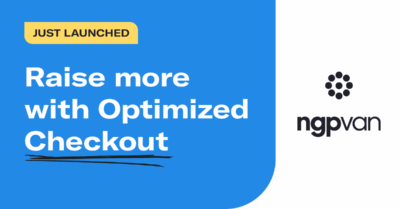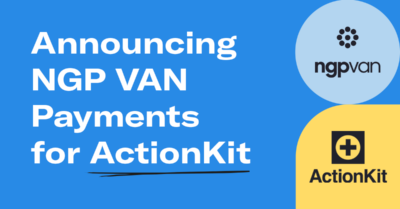PAC fundraising: raising money to influence elections

In 2023, federal political action committees (PACs) raised over $3.6 billion to support political campaigns and causes,and state and local PACs raised a significant sum to help influence elections too. But how exactly does PAC fundraising work? Who funds PACs, and where does the money go?
We’ll explore the basics of this type of political fundraising, including how PAC fundraising works, some of its laws and regulations, and a few ideas to help PACs raise more.
What is a PAC?
A PAC is an entity formed by individuals, organizations, corporations, or unions to raise funds to help influence elections. They impact elections because they can donate to candidates and campaigns (within defined limits) and conduct independent expenditures (without limits) to help support the election or defeat of candidates.
PACs endorse and financially support specific candidates and causes. Individuals and corporations donate to the PAC, then the committee donates the pooled funds to political campaigns or uses them to create political ads, perform field work, or do other election-related activities.
PACs can also conduct independent expenditures (sometimes called IEs). The FEC defines an independent expenditure as “an expenditure for a communication, such as an advertisement through a website, digital device, application, advertising platform, newspaper, TV or direct mail” that expressly advocates for the election or defeat of a candidate and “is not made in consultation or cooperation with, or at the request or suggestion of” a candidate, their authorized agents, or a political party or its agents.
While spending and reporting guidelines vary based on the level of race PACs are attempting to influence, independent expenditures can have a significant impact on elections as they add to the various expenditures made by campaigns. These independent expenditures will need to be reported, but reporting guidelines vary, so check with your relevant election authority to ensure compliance.
Why is PAC fundraising a contentious topic?
The influence of PACs has been called into question since their creation. Some believe that the influence of PAC money in politics can be detrimental as it can sometimes cause concerns that an elected official’s votes may be swayed by their contributors (especially PACs). Many Democratic candidates have pledged to never take any PAC money based on their belief that campaigns should be funded by individual donors or their desire to eliminate any conversations about how their votes were influenced by their donors. Others have pledged to take no corporate PAC money while still accepting contributions from other non-corporate PACs (like union PACs and other ideological PACs).
Regardless of where you stand on whether PACs are beneficial in the progressive political space, there’s no question that many of them continue to play an important role in helping elect more Democrats and advancing progressive causes nationwide. But what exactly do PACs do?
Why do PACs raise funds?
The purpose of PAC fundraising must be to impact elections. PACs raise funds to influence elections in a few ways. They can do so by:
- Donating directly to political campaigns for any local, state, or federal office (*traditional PACs only, Super PACs cannot)
- Paying for political advertisements on TV, social media, or other communication channels (*as long as these advertisements are not made in cooperation with the candidate or at their request — check with your relevant election authority to ensure compliance with relevant laws)
- Financing get out the vote (GOTV) initiatives to help turn out voters for important candidates or causes
Essentially, PACs raise funds to attain more political power and use it to influence elections in ways that align with the group’s ideals and goals.
What types of PACs are there?
While all PACs are classified as 527 nonprofits and most are subject to strict contribution limits that differ depending on where they’re formed and what elections they want to influence, they may fall into one of three different categories:
Connected PACs (SSFs)
Separate segregated funds (SSFs) are PACs started by and connected to a specific corporation, labor union, or trade association. This way, these groups that cannot donate to political campaigns directly can still influence elections through contributions and other expenditures.
Connected PACs raise funds only from individuals associated with their company or association (known as a “restricted class” or “solicitable class”), and funding for the PAC must be kept in a separate bank account from other funds. In practice, this means that SSFs can collect donations from:
- Employees
- Shareholders
- Members
- Corporate executives
Additionally, for trade association PACs, prior approval must be granted by members before they can be solicited for a donation to the PAC. Corporate SSFs represent the vast majority of PACs — in 2024, corporate PACs contributed over $2 billion more than labor PACs. These PACs give corporations much more power in influencing elections and policy decisions.
Labor PACs
Labor PACs are connected PACs that are explicitly tied to labor unions. Sometimes, candidates or causes will accept contributions from a labor PAC, but refuse them from corporate or trade association PACs.
Corporate and trade association PACs
Additionally, for trade association PACs, prior approval must be granted by members before they can be solicited for a donation to the PAC. Corporate SSFs represent the vast majority of PACs — so far in 2024, corporate PACs have contributed over $2 billion more than labor PACs. While these funds are comprised of individual employees and members of their parent organizations, they give the appearance of corporate power in influencing elections and policy decisions.
Types of Nonconnected PACs (commonly just referred to as PACs)
In contrast to SSFs, nonconnected PACs are not associated with any specific company or group. This opens up their PAC fundraising opportunities and allows them to accept donations from the general public. Common types of nonconnected PACs include:
Leadership PACs
Leadership PACs are started by political leaders or candidates themselves that are not legally affiliated with specific campaigns. These PACs are often created to help politicians donate to other candidates in their party to help vulnerable incumbents protect their seats or take back seats in close races, and hopefully earn some goodwill that they can make use of in the future if they decide to run for a leadership position or for higher office.
Super PACs
Super PACs are another type of nonconnected PAC, but they warrant their own section due to their complexity and recent media attention.
Super PACs were only established in 2010 based on a Supreme Court decision called Citizens United v. FEC. In this case, the Supreme Court ruled that super PACs can accept unlimited individual and corporate donations but cannot contribute directly to political campaigns.
While traditional PACs (both SSFs and nonconnected PACs) must follow strict contribution limits for how much they can accept from individual donors and give to specific campaigns, super PACs do not. Instead, they can accept and spend unlimited amounts on advertising for candidates as long as they don’t give money to candidates directly. Super PAC fundraising and advertising efforts are not allowed to be coordinated with candidates, either, although this has proven more difficult to regulate.
Hybrid PACs
In 2011, a judge ruled in Carey v. Federal Election Commission, allowing the creation of hybrid PACs. Hybrid PACs (sometimes called Carey PACs or Carey Committees after the court case that established them) are PACs that maintain one bank account for contributing to campaigns (which is subject to contribution limits) and another account for independent expenditures like ad campaigns (with unlimited contributions). They are half regular PAC, half Super PAC.
How does PAC fundraising work?
PAC fundraising works differently for different types of PACs. While nonconnected PACs raise funds from the public and SSFs raise funds from individuals associated with their company or group, super PACs can accept unlimited donations from anyone. Naturally, each type of PAC takes a different fundraising approach based on who their donors are.
To clarify how PAC fundraising works for different types of PACs, we’ve broken down the main sources of funding for PACs:
Individual contributions to a federal PAC
All types of PACs can accept donations from individuals, but SSFs can only solicit and receive donations from those associated with their sponsoring organization, in their restricted class. Individuals may donate up to $5,000 to a traditional federal PAC each year.
Connected PACs fundraise by soliciting donations internally from their shareholders, employees, or member base. You often see these types of organizations raise money via payroll deductions. Nonconnected PACs may take a variety of fundraising approaches to solicit individuals in the general public who align with their interests.
Corporate and union donations
Corporations and unions themselves cannot donate to traditional PACs, although their employees and members can. However, companies and unions can donate unlimited corporate or organizational funds to super PACs.
Super PAC fundraising contributions
Super PAC fundraising involves soliciting donations from individuals, corporations, and labor unions to fund political advertisements and other independent expenditures. There are no limits on how much an individual or corporation can donate to super PACs, although every donation must be tracked and reported in compliance with FEC (or relevant election authority) and IRS laws.
PAC fundraising laws and regulations
PAC fundraising is highly regulated, so it’s crucial to understand contribution limits, reporting requirements, and other regulations before you begin fundraising.
Check with your relevant election authority to clarify which laws and regulations apply to your PAC. Some of the most important FEC regulations for PAC fundraising include:
- Traditional PACs can only accept up to $5,000 per year from each individual donor.
- SSFs can accept donations from individuals associated with their company or association (called a “restricted class” of individuals) but not from the company or association itself.
- You must keep detailed records of all donations received and report them to the FEC.
- PACs cannot donate more than $5,000 to a candidate or campaign per election.
- Super PACs cannot contribute directly to candidates but may spend unlimited fundraising revenue on independent expenditures.
You also need to follow the relevant PAC fundraising reporting requirements for your committee. This typically involves sending monthly or quarterly fundraising reports to the FEC along with filing relevant IRS forms.
To maintain compliance with all relevant laws and keep track of your PAC fundraising revenue, use specialized PAC management software. This tool helps you track donations, communicate with donors, and file the right compliance reports as needed.
PAC fundraising ideas for traditional PACs
Nonconnected PACs looking to solicit donations from the general public need to use creative PAC fundraising strategies to earn the most donations.
If you’re fundraising for a PAC, first ensure that your PAC has a website with a user-friendly donation page. This page is where most donors will make their contributions, so it needs to be accessible, mobile-friendly, and compelling to existing and new donors alike.
Then, use several PAC fundraising ideas to round out a balanced fundraising strategy. Diversifying your fundraising methods will help you meet donors where they are and increase the chances of you raising the money you need for your PAC. Consider the following questions and suggestions when developing your fundraising strategy:
- Soliciting donors through different channels: Are you focusing on raising high-dollar or low-dollar donations (or both)? Depending on the type of donors you’re hoping to solicit, you may approach them through different channels. While effective fundraising programs use multichannel outreach to meet donors where they are, high-dollar and low-dollar donors typically require different levels of outreach and effort before they contribute to your PAC. Typically, low-dollar donors may donate through an email or text, while high-dollar donors may want to attend an event or be called personally before contributing.
- Calling donors to give: Call time is a tried and true political fundraising strategy that can help you raise money fast. By personally calling donors, you can build rapport with them, learn about what issues are important to them, address any concerns they may have, and make a personal ask. While time-consuming, call time is undoubtedly one of the most effective ways to raise money for your PAC.
- Raising money for your SSF: Are you using payroll deductions to help boost your fundraising totals? Or are you hosting events or sending appeals to raise money from and build relationships with your restricted class?
- Hosting fundraisers: Fundraisers can be an impactful way to raise money for your PAC, but they can cost a lot of money and require significant planning. If you’re planning fundraisers, aim to keep your event costs to one-third or less of the projected fundraising total to ensure that you’re time is well spent.
- Sending fundraising emails: Create several fundraising emails to send to those who have donated to or interacted with your PAC in the past. Keep your content short and actionable, and address prospective donors personally.
- Encouraging one-time donors to become recurring donors: While some donors may only give once during the election cycle, others may give multiple times if they’re asked. Some may even set up recurring donations to consistently give to your PAC. Encourage your donors to become monthly or recurring supporters for a more stable fundraising base for your PAC.
- Peer-to-peer fundraising: Peer-to-peer, or P2P, fundraising invites your loyal supporters to spread the word about your PAC and ask their friends and family to donate to the cause.
Don’t forget about donor recognition. Thank you letters and notes can go a long way in helping your donors feel like their contribution made a difference, and they should help retain loyal donors who will give to your PAC again in the future.
Streamline PAC fundraising and compliance with NGP VAN
PAC fundraising and compliance is a complex process that involves maintaining awareness of several laws and regulations. To streamline your fundraising process, stay compliant, and make more of a difference in politics, get started with NGP VAN’s leading solutions for Democratic and progressive campaigns and PACs. Get a demo to learn more about how NGP VAN platforms can support your PAC fundraising efforts.



